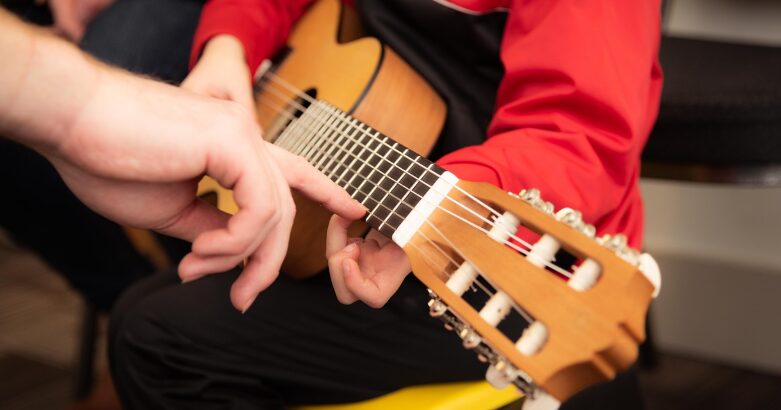With so many tutorials, live classes, and experienced instructors at your fingertips, the options to learn guitar are virtually limitless. Selecting online guitar lessons would be ideal for you and is similar to going on a musical treasure hunt. Your lessons point to the route, but how well you follow it will determine how far you can travel.
As a beginner strumming the first chord or an intermediate advancing on to more complex solos, there are many ways you could make the most out of the online learning experience. Let us go through some useful tips to make your online guitar lessons more interesting and effective.
How to Make Your Online Guitar Lessons Effective?
1. Find the Right Platform and Instructor
Imagine going for a buffet with countless choices. You would choose what pleases your tummy rather than stuffing your plate full of everything, right? Choosing a guitar learning platform and instructor follows the same logic.
How to Make the Choice?
- Matching Skill Level: Choose the platforms that are like the comfort place of learning – easy to follow and structured – regardless of your level of experience.
- Teaching Style: Some teachers are enthusiastic, motivating cheerleaders, while others are strict coaches who prioritize accuracy. See who you connect with by watching their sample lessons.
- Genre Specialization: Do you prefer soulful blues, furious rock, or intricate fingerstyle? Choose someone who’s fluent in your musical language.
2. Set Up a Creative Space
Your creative space is where you can practice your craft without interruptions. Creating the ideal atmosphere is crucial since a messy or noisy space can divert your attention more quickly than a broken guitar string.
What Your Space Needs?
- Comfortable Seating: Just like a nice pair of shoes, the chair you choose for your space is important. Use one without armrests to improve your posture and range of motion.
- Bright Lighting: Everything is visible under ideal lighting, including fretboard details and chord charts.
- Internet connectivity: A stable internet connection is a must. Bad connectivity leads to laggy video calls and feels like attempting to tune a guitar with a faulty tuner.
- Stay Prepared: Your classes sound clear and engaging when you listen with headphones. Keep your notepad, guitar, picks, and tuner in reach and always be prepared to jump into action.
3. Create a Routine for Practice
Regular practice is like watering a plant. It grows steadily if you do a little each day, but it can backfire if you forget or do too much. Consistency, rather than irregular bursts of effort, is the key to guitar excellence.
How to Establish a Pattern?
- Set Your Goals: Divide the goals like “play a full song” into more easy ones like “learn the chord progression.”
- Everyday Practice Period: Set aside at least 20 to 30 minutes each day. Even brief, focused sessions are very effective.
- First, Warm Up: Warming up your fingertips is as important as sportsmen stretching before a game. Basic finger exercises or scales can do the trick.
4. Take Part in Lessons Actively
Online courses can occasionally appear passive, particularly if you’re watching videos that have already been filmed. Make every session an interactive experience to get the most out of them.
How to Keep Yourself Involved?
- Ask Questions: If you’re in a live class, don’t be afraid to ask questions. Take notes during recorded lessons and look up the answers later.
- Play Along: Take a moment to practice with the instructor rather than just watching them play.
- Make Notes: Jot down important ideas, advice, and activities. Going over your notes again helps you remember what you’ve learnt.
5. Back Up Your Lessons with Additional Resources
You start with online lessons, but why stop there? Exploring other resources enriches what you learn and makes it enjoyable, much like adding spices to food.
What to Explore?
- One-on-One Live Classes: Live sessions guarantee that each lesson is customized to your pace, goals, and interests. Personalized attention is essential for faster improvement.
- Progress Tracking Tools: Keep track of your progress over time by highlighting areas for improvement and recording your accomplishments. This helps you focus your practice.
- Flexible Scheduling: Life can get busy, join a platform that provides flexible scheduling choices so you can easily fit your classes into your schedule.
- Global Learning Community: Interact with other guitar players across the world to swap stories, offer advice, and maintain motivation as you go.
Bonus Tips: Be Patient and Appreciate Small Victories
Learning how to play guitar for beginners is a journey rather than a race. Even while progress may seem glacial at times, every little victory is worthwhile, whether it’s conquering a challenging chord or finally getting a riff down pat.
How to Stay Motivated?
- To monitor your progress, record yourself on a regular basis.
- Reward yourself when you reach goals like finishing a course module or learning an entire song.
- Do not forget why you began.
As Eric Clapton said, “The beautiful thing about learning is nobody can take it away from you.”
Wrap Up
Playing the guitar is more than just learning how to play it; it’s a process of self-expression, self-control, and self-discovery. Showing up is not enough if you want to get better every day; you also need to show up prepared. Whether it’s choosing the best guide, setting up your practice space, or exploring the resources accessible, keep in mind that the true magic lies in how you do your part.
Your guitar will always be prepared to sing your story if you are ready to write one, regardless of whether your goal is to perform in front of an audience or just lose yourself in the music.



































